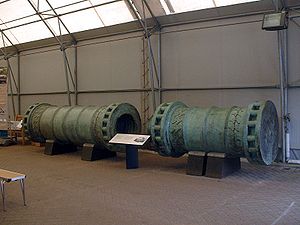Dardanelles Gun
| Basillica | |
|---|---|
 Dismantled Dardanelles Gun at Fort Nelson, Hampshire, overlooking Portsmouth | |
| Type | Bombard |
| Service history | |
| Used by | Ottoman Empire |
| Wars | Dardanelles operation |
| Production history | |
| Designer | Munir Ali[1] |
| Designed | 1464[2] |
| Specifications | |
| Mass | 16,800 kg (37,000 lb)[2] |
| Barrel length | 518 cm (204 in)[1] |
| Diameter | 1,054 mm (41.5 in) |
| Caliber | 918 mm (36.1 in)[1] |
| Action | slow match |
| Elevation | none |
| Traverse | none |
| Feed system | muzzle loader |
The Dardanelles Gun[3] or Great Turkish Bombard[2] (Turkish: Şahi topu or simply Şahi) is a 15th-century siege cannon, specifically a super-sized bombard, which saw action in the 1807 Dardanelles operation.[4] It was built in 1464 by Ottoman military engineer Munir Ali and modelled after Basillica, the Orban bombard that was used for the Ottoman besiegers of Constantinople in 1453.
History
The Dardanelles Gun was cast in bronze in 1464 by Munir Ali with a weight of 16.8 tonnes and a length of 5.18 m (17.0 ft), being capable of firing stone balls of up to 0.63 m diameter (24.8 in).[1] The powder chamber and the barrel are connected by the way of a screw mechanism, allowing easier transport of the unwieldy device.
Such super-sized bombards had been employed in Ottoman warfare
At the
Along with other huge cannons, the Dardanelles Gun was still present for duty more than 340 years later in 1807, when a
The gun was being considered for scrapping by 1850 but this was held off after
See also
- List of the largest cannon by calibre
Notes
- ^ a b c d Schmidtchen (1977b), pp. 226–228
- ^ a b c "Gun - Turkish Bombard Also referred to as the Dardanelles gun and the Great Bronze Gun. Two large bronze pieces, the smaller powder chamber cast at one end with a screw thread to engage the female thread of the larger piece". Royal Armouries collections. Retrieved 18 May 2023.
- ^ Ffoulkes (1930), pp. 217–227; Schmidtchen (1977b), pp. 226–228
- ^ a b Schmidtchen (1977b), p. 228
- ^ ISBN 9780521843133.
- ^ Schmidtchen (1977a), pp. 153–157
- ^ Paul E. J. Hammer (2007), Warfare in Early Modern Europe 1450–1660, page 297, Ashgate Publishing
- ISBN 9780262195164.
- ISBN 9781351873765.
- ^ a b c Schmidtchen (1977b), p. 226
- ^ ISBN 9781913013400.
- ^ "Geometry of War – Pg. 6" (PDF). Archived from the original (PDF) on 15 June 2011. Retrieved 7 September 2007.
Sources
- Ffoulkes, Charles, "The 'Dardanelles' Gun at the Tower", Antiquarian Journal, Vol. 10 (1930), pp. 217–227
- Schmidtchen, Volker (1977a), "Riesengeschütze des 15. Jahrhunderts. Technische Höchstleistungen ihrer Zeit", Technikgeschichte 44 (2): 153–173 (153–157)
- Schmidtchen, Volker (1977b), "Riesengeschütze des 15. Jahrhunderts. Technische Höchstleistungen ihrer Zeit", Technikgeschichte 44 (3): 213–237 (226–228)
External links
![]() Media related to Dardanelles Gun at Wikimedia Commons
Media related to Dardanelles Gun at Wikimedia Commons
